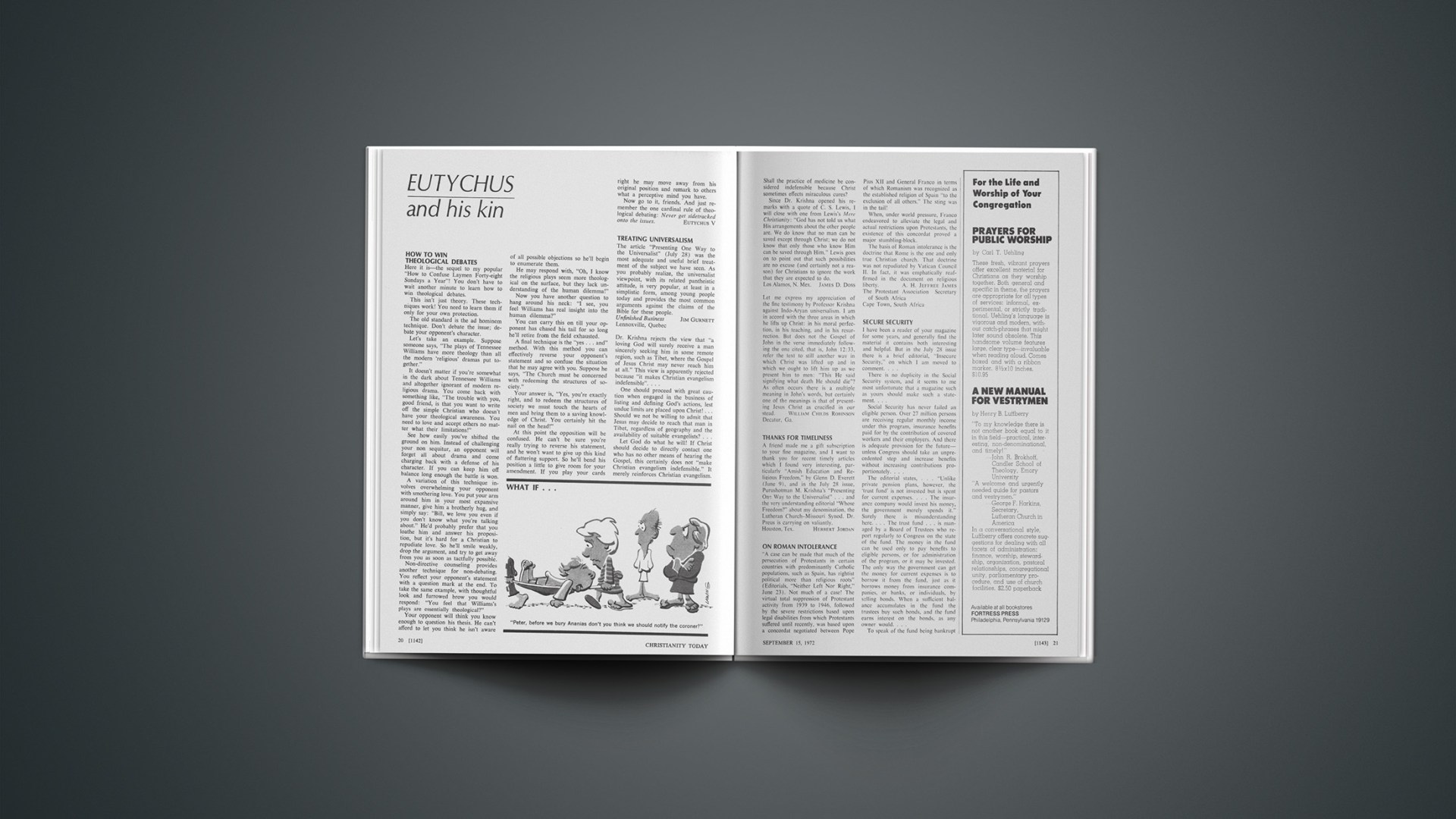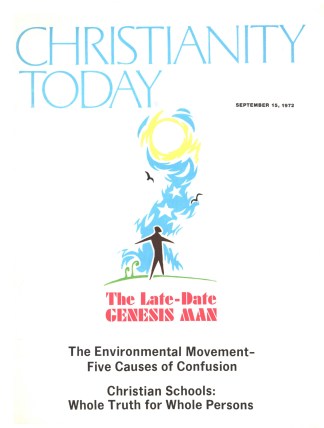In an editorial entitled “Insecure Security” (July 28 issue) we criticized the system of Social Security currently practiced in the United States—not the desirability of retirement, survivors’, and disability benefits, but the confusing and, we believe, misleading terminology and arguments used to sell Social Security to the voting public. The editorial called forth a swarm of comments from readers (see, for example, p. 21).
We do not suggest that the U. S. government is going to default on its promises, but we do feel there is a notable gap between what is being promised and what is being done to make fulfillment possible. We asked an independent financial analyst to present the facts of the situation as he sees them. Elgin Groseclose is a financial consultant with Groseclose, Williams and Associates in Washington, D. C., and executive director of the Institute for Monetary Research.
When the Lord provided the Children of Israel with manna each day sufficient for the day, those who saved it for the morrow found that “it bred worms and stank.” Those who find in the Bible economic wisdom as well as divine truth may ponder the Israelite experience with manna in considering the efforts, public and private, to set aside financial reserves against old age, incapacity, or unemployment. Under the prevailing monetary system and theory, financial reserves are like manna, with a “taste of wafers made with honey” that nevertheless melt, when the sun of adversity arises, into nothing.
The reason is that money has ceased to represent tangible wealth and is no more than an evidence of debt, either public or private. To be precise, a bank balance or savings account may appear to be a solid reserve to the depositor, but what he holds is only the IOU of the institution: the bank or the savings institution promptly disburses the sum as a loan that the lender immediately spends for either goods or services. The insubstantiality of the deposit is concealed by a facade of guarantees, public and private, and by the continual replenishment of the institution’s funds by new deposits. One need only postulate a community crisis, such as a universal bank failure like that of 1933, or an invasion by a foreign foe, to discover the fragility of money. In such an event, unlikely but not inconceivable, where would these reserves be?
Some people consider Federal Reserve notes and other currency that misers store in old trunks to be safer than the bank. These, too, are no more than notes of hand, no longer backed by any precious substance such as gold.
The implications of this are not always clear to advocates of a public pension system such as the Old Age and Survivors Insurance Fund, commonly known as Social Security. (It is this fund, not the Disability Insurance Fund or other programs, that is the subject of this article.) Again, no tangible wealth supports the reserve, since it is invested in bonds, that is, debt obligations. Moreover, what hastens the impermanence—the manna quality—of the OASI reserve is that the funds represented by the bonds are largely sterile and non-productive, adding an inflationary leverage to the economy and thereby diminishing the value of the dollars collected. This is because the OASI reserve—unlike one’s private savings in, say, a building and loan society, which flow into wealth creating uses like new homes—is invested in government bonds and hence devoted to financing federal deficits incurred in support of what is generally regarded as non-productive expenditures, such as foreign aid, foreign military costs, and welfare payments to persons not working or producing.
This is not the extent of the inflationary, or dollar-depreciating, consequences of Social Security. Contrary to its name and the fond belief of many, the Old Age and Survivors Insurance Fund is not insurance as commonly understood. Insurance implies the existence of reserves accumulated from premiums and interest payments thereon sufficient to meet computed liabilities. Actuarial estimates made in 1959 by W. Rulon Williamson, former actuary of the system, calculated that under the benefits then in effect the unfunded actuarial liability was between $350 and $650 billion, depending upon the mode of calculation, as against an accumulation in the fund of less than $35 billion. This is, of course, fortunate; if the fund were actuarially sound it would provide such a reservoir for deficit financing, such an engine of inflation, as to appall the most ardent Keynesian.
As another leading actuary, Geoffrey N. Calvert, long ago pointed out in a government brief before the Supreme Court, “Social security must be viewed as a welfare instrument to which legal concepts of ‘insurance,’ ‘property,’ ‘vested rights,’ ‘annuities,’ etc. can be applied only at the risk of a serious distortion of language.” There is no paid-in or cash surrender value, and a wage-earner normally has to reach age sixty-five—a matter out of human hands—to obtain benefits from his many years of payments. Even his widow, if he dies prematurely, cannot benefit until she attains age sixty-two.
That the OASI is in fact a pay-as-you-go system is illustrated by the results from the 1970 fiscal year, for which the trustees of the fund reported net “contributions” (euphemism for taxes) of $30 billion and benefit payments of $26 billion. This flow of funds does not lessen the inflationary impact; rather, it accelerates it, for again, under the peculiar theory in which the system was conceived, beneficiaries are discouraged from engaging in productive activities by the penalty imposed on earnings in excess of $1,680 a year. The net result of this is to take out of the productive economy some 30 million persons, most of whom are still socially and economically useful, while at the same time injecting some $26 billion of purchasing power. This creates the classical imbalance between money in circulation and goods in the market that pushes prices upward and the value of the dollar downward.
The melting of the manna of Social Security may be traced in the declining value of the benefits. The dollars that wage-earners paid in during the early years of the system have now dissolved to about a third of their original purchasing power—partly the effect of a system that enables a government continually to run into debt (a phenomenon, incidentally, that began with the Social Security system and has run concurrently with it ever since).
The idea that a Social Security system is the national equivalent of the “well-stocked family cellar,” to which the arch-conservative Herbert Hoover was wont to refer, is an illusion whose recent historic parallel is that which held the French nation in thrall when John Law proposed to coin the very soil of the realm into money.
To conclude, economists and churchmen have yet to deal with the implications of our Lord’s injunction, “Do not be anxious about tomorrow, for tomorrow will be anxious for itself. Let the day’s own trouble be sufficient for the day.”










